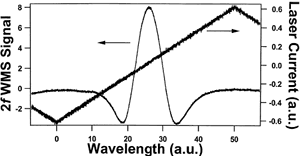Wavelength Agile External Cavity Diode Laser
U. S. Patent 6,683,895, issued January 27, 2004
Diode lasers tune in wavelength as a result of several competing factors:
the gain profile and the index of refraction both depend on temperature, and
the temperature and the index of refraction depend on injected current. In
the simplest type of diode laser, the "Fabry-Perot" laser, the emitted
wavelength can jump suddenly from one cavity mode to another as a result of
these competing influences. Such erractic tuning makes FP lasers poorly suited
for spectroscopy. Distributed feedback structures built onto the laser can
stabilize the operating wavelength, resulting in continuous tuning, but such
structures are not available at many important diode laser wavelengths, and
they don't permit tuning over the full wavelength range of the laser's gain
profile. External cavity lasers use a grating to stabilize the operating wavelength.
They can tune over the full wavelength range supported by the diode laser,
but the typically tune by carefully adjusting the cavity grating in a way
that permits single mode tuning. The result is slow mechanical tuning and
a high cost.
This invention describes a much simpler tuning approach. The laser wavelength is tuned by adjusting the injection current, and the laser hops from one mode of the external cavity to the next. The grating stabilizes the tuning, making it reproducible. By using a long optical cavity, these mode hops can be much smaller than the line width of the spectroscopic transition to be detected and hence the tuning is quasi-continuous. Moreover, the cavity tuning can be accomplished very rapidly, permitting the use of modulation techniques that improve the detection sensitivity. The result is an electronically scanned laser spectrometer that can be built at any wavlength where Fabry-Perot diode lasers are available. The figure shows a wavelength modulation spectrum taken using such a laser.
Contact Information
e-mail info@swsciences.com

